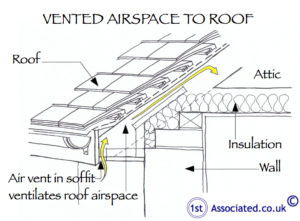Thermal Characteristics
of a Victorian Property
If you need help and advice with regard to independent valuations, property surveys, building surveys, structural reports, engineers reports, specific defects report, structural surveys, home buyers reports or any other property matters please free phone 0800 298 5424 for a friendly chat with one of our surveyors. During the survey we like to meet you at the property and we are more than happy to talk to you about the reports.
Please free phone 0800 298 5424 for a friendly chat with one of our surveyors.
Free phone 0800 298 5424
Victorian Properties
Victorian properties look like this:
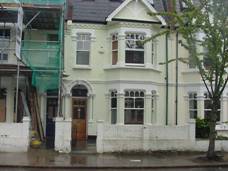 |
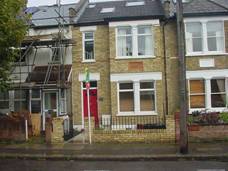 |
|
|
Two storey terraced Victorian property with loft extension |
Heat loss in a house
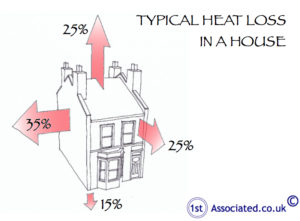
The sketch shows generally how properties lose heat:
25% of heat can be lost through the roof
35% through the walls
25% through the windows
15% through the floors
Amendments and alterations that take place over the years can affect how the heat is lost.
Heat loss in a Victorian property
Let's look at a Victorian property elevation by elevation.
Front Elevation
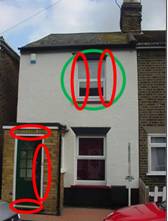 In this terrace style Georgian/Victorian property we would expect the main heat loss to be via the largest areas such as the walls and the roof. We know that roof insulation has been added in this instance and expect the flat roof to the porch to lose heat. This is directly adjacent to the lounge which is usually one of the warmest areas in a house. Heat would also be lost through the flat roof to the porch and around the side of the double glazed windows where we usually find they have not been adequately sealed.
In this terrace style Georgian/Victorian property we would expect the main heat loss to be via the largest areas such as the walls and the roof. We know that roof insulation has been added in this instance and expect the flat roof to the porch to lose heat. This is directly adjacent to the lounge which is usually one of the warmest areas in a house. Heat would also be lost through the flat roof to the porch and around the side of the double glazed windows where we usually find they have not been adequately sealed.
We have used red circles to show where heat is lost (in this instance the flat roof and the sides of the windows) and a green circle to show good thermal properties, which in this instance are the double glazed windows and also out of sight, but we know it is there as we have been in the roof, is a well insulated roof (please see the next section to learn more about the roofs).
Roofs
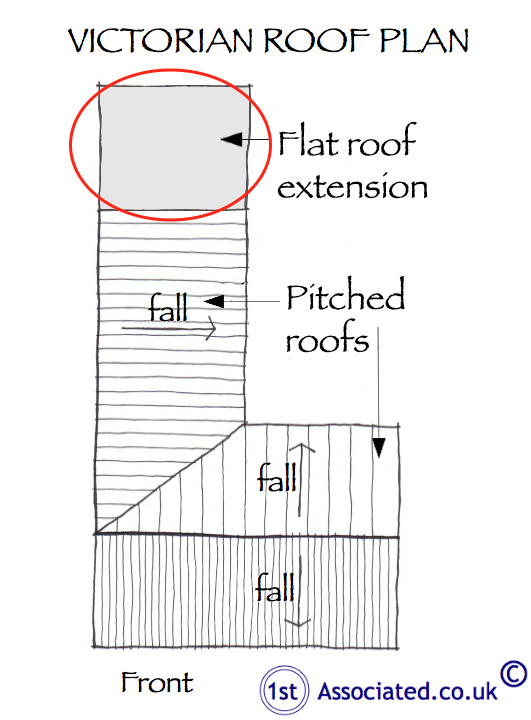 This is a plan view, which means it is looking down on the roof of a typical Victorian style property.
This is a plan view, which means it is looking down on the roof of a typical Victorian style property.
We can use a roof layout such as this as many of the Victorian properties were built in a similar way with similar proportions.
Main pitched slate roof
We would expect minimal heat loss to be visible from the pitched roofs if we could take a thermal image photograph from above due to the insulation we found within the roof space. The main issue we would say with the roof insulation is that possibly it has been over insulated without any ventilation and therefore condensation can occur. In this case there are vents within the soffits which should give an airflow into the roof space however this may well have been blocked by the insulation. We also like to see ridge vents which are vents at the very top of the roof which allow airflow.
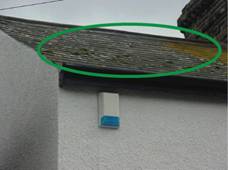 |
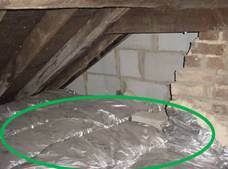 |
|
|
Insulation within roof space |
|
|
|
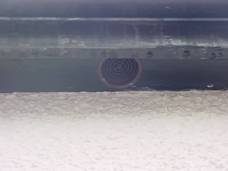 |
|
|
Air vents to soffits |
This vent should be giving airflow into the roof space to minimise condensation. |
Front porch roof
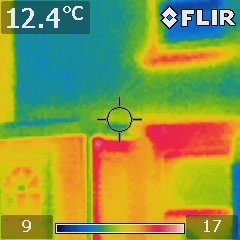
Heat will also be lost through the flat roof to the porch.
Rear Flat Roof
We comment on the rear flat roof in the rear elevation section of this article.
Chimney
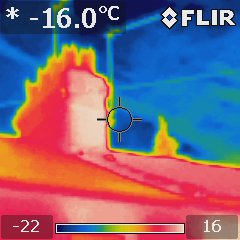
As you can see in the thermal image, the brick chimney absorbed more heat than the actual roof.
Walls
In the Victorian era we would expect to see a solid wall such as the Flemish bond brickwork that you can see in the adjoining sketch. There was no insulation in these walls other than the mass of walls which many do argue in itself gives fairly good insulation although not up to modern standards.
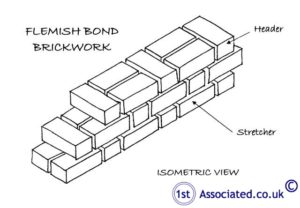 |
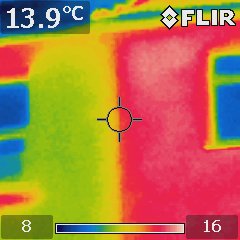 |
|
|
Contrast between render on left hand side of your property and bricks on right hand side which absorb heat during the day from the sun |
Window and Doors

We generally find that in Victorian properties draughts are the main factors that make the property feel cold. These are particularly around doors and windows. Interestingly, it has also been shown that the use of internal wooden shutters as we once used to use, and good thick curtains also help considerably to save heat loss.
As a reminder with regard to our system of circles, the green circle represents a good thermal efficiency standard and red a poor thermal efficiency standard.
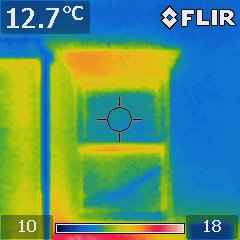 |
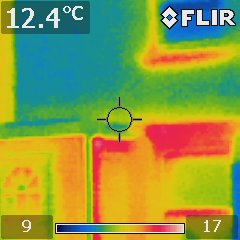 |
|
Window – Some heat coming out on the middle transom (middle bar) and some heat on the top transom (top bar). Brick soldier course giving out some heat. White render is in shown as blue area |
Heat escaping around windows |
Floors

Many older Victorian properties have a suspended timber floor although this particular property didn't. You could insulate beneath a suspended timber floor although you do have to remember that these floors need to breathe to reduce the chances of wet and dry rot. Insulation added to the floors can improve the thermal efficiency considerably however where a concrete floor is in place, if an insulation is added, it would then mean you would have to adjust the doors as the height of the floor would rise. We find a more practical solution, although nowhere near the same thermal properties, is to use a very thick underlay and good quality carpet.
Rear Elevation
Main Roof

Please see our comments in the front elevation. This is a well insulated main roof
Flat Roof
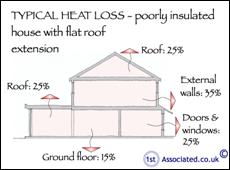 There is a large flat roof to the rear of the property that is over the kitchen and the dining room area. Given the age of this flat roof, we can tell this being a surveyor for various reasons, such as the type of felt used, the type of roof light used, and various other things, we believe this is a cold deck flat roof which means there is no insulation in it (please see our sketch below).
There is a large flat roof to the rear of the property that is over the kitchen and the dining room area. Given the age of this flat roof, we can tell this being a surveyor for various reasons, such as the type of felt used, the type of roof light used, and various other things, we believe this is a cold deck flat roof which means there is no insulation in it (please see our sketch below).
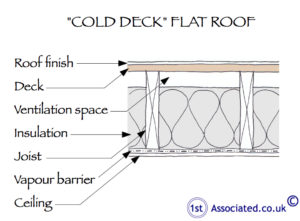 |
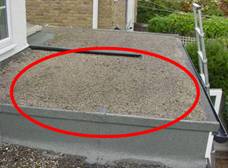 |
|
No insulation to flat roof |
Rear flat roof |
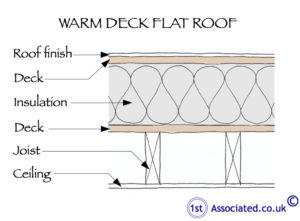
Improvements could be made to the thermal qualities of the roof by adding insulation to it and producing a warm deck.
Gable End Wall
Main Roof
Again, please see our comments in the front elevation.
Walls

In this case we noticed whilst carrying out our survey that the top of the gable end of the wall has a single brick skin and as such will have a high thermal loss from this area. We were also pleased to see some airbricks in it although we do not believe they are sufficient given the amount of insulation in the property.
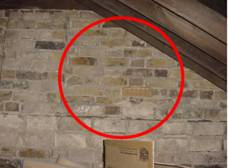
ACTION REQUIRED: As the roof space isn't a habitable area, we would tend to leave the construction as it is. The caveat that we have already mentioned is that the air movement within the roof needs to be improved to stop future mould and deterioration to the timbers.
Breathable buildings (also known as airy buildings) versus airtight buildings
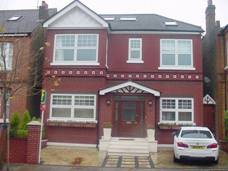
We think the jury is still out as to whether breathable buildings are better than airtight buildings. New construction has moved to airtight construction and as such there is a lot of publicity for the new thermal values as after all they are trying to sell the new properties (there is no such similar marketing for older properties). The new house builders consider that it is often air movement draughts that make you feel cold and also it is a waste letting warm air out and cold air into a property. Their aim is for you to warm up the air and then have a controlled circulation of this throughout the property with minimal heat loss which is carried out by insulating the floors, the walls, the ceilings and the roofs.
Heating Systems
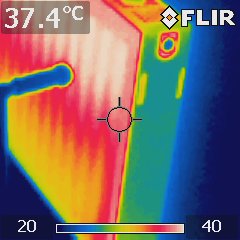
Lots of insulation will help reduce heat loss but if you don't have efficient boilers then energy is being wasted here too. Again, we would say that the jury is still out with regard to new boilers because we are finding that they need more maintenance as they are more technical than older style boilers. We were talking to a maintenance manager the other day who advised how older style boilers work for thirty years plus, the reasonably modern boilers work for ten to fifteen years, now they are finding the newer boilers seem to be working for five to ten years and require a lot more maintenance. We would add that this wasn't a scientific testing, just the experience of a maintenance manager looking after a lot of different properties.
Problems that we have found in Victorian properties with over insulating
Care needs to be taken in older properties that you do not over insulate without ventilating as this can lead to condensation and mould, often in hidden areas. This is known as interstitial condensation where it is within the structure. In the roof space this looked to be starting in this instance and the roof therefore requires ventilation.
Independent Surveyors
If you truly do want an independent expert opinion from a building surveyor we are happy to carry out valuations, building surveys, structural surveys, structural reports, engineer's reports, specific defects reports, home buyers reports or any other property matters. Please contact 800 298 5424 to have a free of charge friendly chat with one of our surveyors.
We feel our surveys are quite unique, as they are written by our chartered surveyors to your level of knowledge. The surveys include photos and sketches and definitions. The survey will also include an action required section and an estimate of costs in the executive summary. Our chartered surveyors are more than happy to meet you at the property whilst carrying out the survey to discuss any specific issues you may have or have a general chat about what we have found at the end of the survey.
Commercial Property
We do come across from time to time commercial properties that have been built with a timber frame, particularly on older shops. If you are looking for commercial property, whether it is freehold or leasehold, we would recommend a survey as this will prevent dilapidations claims in the long run. You may wish to look at our Dilapidations Website at www.DilapsHelp.com and for Disputes go to our Disputes Help site www.DisputesHelp.com , both of which we have been advised are very helpful!
We hope you found the article of use and if you have any experiences that you feel should be added to this article that would benefit others, or you feel that some of the information that we have put is wrong then we would be pleased to hear from you.
The contents of the website are for general information only and is not intended to be relied upon for specific or general decisions. Appropriate independent professional advice should be paid for before making such a decision.
All rights are reserved the contents of the website are not to be reproduced or transmitted in any form in whole or part without the express written permission of www.1stAssociated.co.uk


